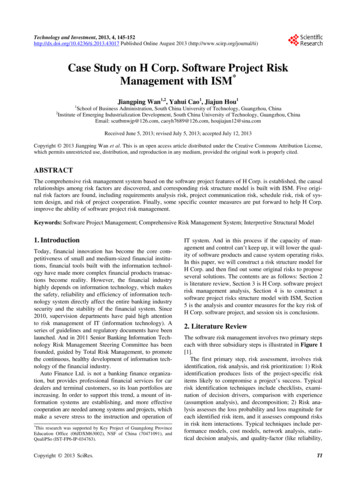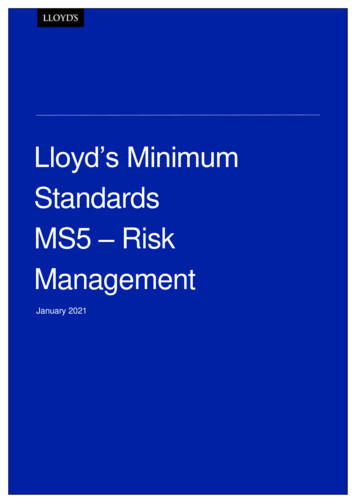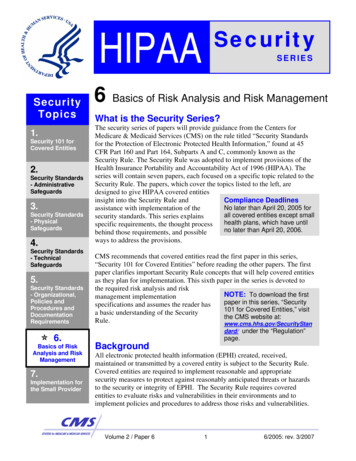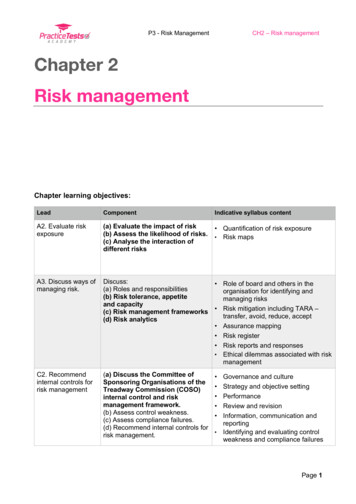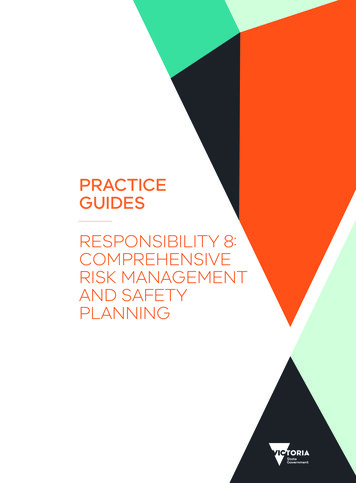
Transcription
PRACTICEGUIDESRESPONSIBILITY 8:COMPREHENSIVERISK MANAGEMENTAND SAFETYPLANNING
RESPONSIBILITY 8Comprehensive Risk Management and Safety Planning8.1Overview3378.2Developing a Comprehensive Risk Management Strategy with the Victim Survivor 3388.3Risk Management when Initial Contact is Limited8.4Risk Management for Post-separation Violence or Where no Separation is Planned 3428.5Risk Management for a Victim Survivor who is not Ready to Engage3448.6Risk Management for a Victim Survivor who is not Ready for Assistance3458.7Safety Plans3468.8Justice System3508.9Safety Plans for Children and Young People3563428.10 Risk Management for an Adolescent who is Using Family Violence3598.11359Managing Risk Across the Community with an Intersectional Lens8.12 Risk Management Considerations for Aboriginal Victim Survivors3608.13 Risk Management Considerations for Diverse Communities and At-risk Age Groups 3608.14 What’s Next?363Appendix 14: Comprehensive Safety Plan364Appendix 15: Ecomap Diagram371NOTE:Guidance and learning objectives for working with perpetrators is in development and will beavailable late 2020. Finalised guidance will make clear that only key/selected professionals andservices will be trained/required to provide a service response to perpetrators related to theiruse of violence.The learning objective for this Responsibility 8 will include:Ensure staff who specialise in working with perpetrators are trained to undertakecomprehensive risk management through development, monitoring and actioning of riskmanagement plans (including information sharing); monitoring across the service system(including justice systems); and actions to hold perpetrators accountable for their actions.This can be through formal and informal system accountability mechanisms that supportperpetrators’ personal accountability to accept responsibility for their actions, and work atthe behaviour change process.335
336 MARAM PRACTICE GUIDES
8COMPREHENSIVE RISKMANAGEMENT AND SAFETYPLANNING8.1OVERVIEWThis guide should be used when familyviolence has been established and acomprehensive risk assessment has beencompleted for an adult, child or youngperson.This guide will assist specialist familyviolence practitioners to apply theiradvanced skills in working effectively withvictim survivors, including acting to respondto the outcomes of comprehensive riskassessment and undertake comprehensiverisk management, safety planning and casemanagement.KEY CAPABILITIESProfessionals required to have knowledge ofResponsibility 8, should be able to: Understand and apply all guidance on eachof the previous responsibilities Confidently and competently plan andundertake a range of risk managementactivities with victim survivors (adults,children and young people) Actively monitor family violence risk andrespond to changes in risk levels throughadjusting risk management activities andsafety plans Proactively share and gather informationon family violence risk including building ashared understanding of a person’s familyviolence risk with other support agencies.Specialist practitioners who use this guideshould also be familiar with the FoundationKnowledge Guide, Responsibilities 1–7, andcontinue to Responsibilities 9–10.Comprehensive risk management is theprocess of responding to identified familyviolence risk. It includes developing,monitoring and actioning safety plansand risk management activities withvictim survivors (adults, children andyoung people). It also includes a focuson ongoing review and assessment (seealso Responsibility 9) to respond to thedynamic nature of risk, and collaborativeinformation sharing to understand risk/sfrom the perpetrator.This chapter builds on the guidance onsafety planning and identifying protectivefactors in Responsibility 4, with additionalrisk management guidance relating to: Safety planning in an emergency, in thehome, when not ready to leave, whenleaving and post separation Engaging with the justice system Providing appropriate risk managementfor Aboriginal people, or people whoidentify as belonging to a diversecommunity Providing appropriate risk managementfor children and young people. Risk management is the focussingof responsibility for the risk on theperpetrator’s behaviour and supportingthe victim survivor in the development ofactions that may reduce harm, or in somecircumstances to remove themselvesfrom harm.RESPONSIBILITY 8: COMPREHENSIVE RISK MANAGEMENT AND SAFETY PLANNING 337
A central part of risk management is alsoproviding a proactive response to removeor reduce threat of future harm posedby the perpetrator. Responses may beinitiated by interventions of a range ofservices, including police or courts, andcan include referral options and criminaland civil responses. The aim of responsesis to reduce risk and provide support forstabilisation and recovery. This can beaccomplished through responding toaddress safety issues and building andreinforcing protective factors.8.2DEVELOPING ACOMPREHENSIVE RISKMANAGEMENT STRATEGYWITH THE VICTIM SURVIVORThe risk management processshould respond appropriately to theassessed level of risk, the form ofviolence that is occurring, as well aslikelihood/timing of risk.An important part of safety planningand risk management is to work with thevictim survivor to understand practicaland structural barriers they face and toincrease protective factors. You shoulduse professional judgement and workin partnership with the victim survivorto maximise safety in ways that arecollaborative, supportive and appropriateto the level of risk.In developing a risk management plan yourdiscussion with the victim survivor mayinclude: Talking about their experience of risk andcentring responsibility for the risk and itsimpacts on the perpetrator’s behaviour Exploring the victim survivor’s selfassessment of risk posed by theperpetrator and protective factors (suchas through the ecomap exercises as adiscussion aide) Considering each child or youngperson and weighing the risk from theperpetrator, the impact of the abuse, andthe protective factors in place for eachindividual child/young person, in how youplan for each individual and the family asa whole338 MARAM PRACTICE GUIDES Responding to your determination ofthe level of risk and specifically actionplanning for key risk factors that havebeen identified as increasing thelikelihood of the victim survivor beingkilled or being seriously harmed by theperpetrator, such as high-risk factorswhich have changed or increased inseverity or frequency which indicateescalation of risk Exploring the risk managementstrategies the victim survivor has alreadytried. Identify those that continue to workand which ones are no longer helpfulor need to be changed to meet currentcircumstances Asking about the victim survivor’sexperiences in engaging with servicesto date, and what organisations/typesof services have been involved (police,health, housing, immigration, legalorganisations, schools etc.) Exploring practical and other needs thatmay impact on their safety planningand ability to remain safe. These maybe housing, health, education needs,children’s needs, employment, finances,relationships with family and friends,pets, and/or the potential loss ofcommunity Exploring the victim survivor’s experienceof violence caused by the perpetrator, orother historic trauma, and what barriershave affected their ability to leave therelationship (if they wish to do so) Understanding the victim survivor’sstrengths, needs and goals to supporttheir safety and recovery, and their child/ren, in the week/month/year ahead Exploring the perpetrator’s involvementwith the service system and identifyingareas that may hold information relevantto risk management. This could bedone through undertaking the ecomapactivity described in Section 8.2.1 andapplying it to what is known about theperpetrator’s engagement with servicesand community. Working with the victim survivor toincrease protective factors shouldinclude the following considerationsand a discussion of possible options(see introduction to protective factors inResponsibility 3).
Table 1: Protective Factors and Risk Management — Areas for DiscussionProtective factordomainsFactorsAreas to coverSystemsinterventionLegal issuesDiscuss legal needs and legal assistance whichcan contribute to improved safety and securityincluding intervention orders, parole conditionsand options.Practical/environmentalSafe housingThe type of accommodation the victimsurvivor has and its location may be importantdeterminants of safety for adults, children andyoung people.Discuss the accommodation required to keepvictim survivors safe. This includes immediate(e.g. emergency) and long-term accommodation.Financial security(access to money,employment oreducation)Income and financial security can act as barriersto leaving the relationship and/or long-termrecovery.Discuss current income arrangements, incomesupport required, and explore other sources offunds, and resources.If the victim survivor is employed, discuss whetherthey feel safe at work (from the perpetrator),whether their employer and co-workers are awareof the family violence and if they understand thedangerousness of the perpetrator, and or are ableto provide some support.Discuss how family violence can affect the victimsurvivor’s work. Ask whether the perpetrator hasever threatened co-workers.Health (includingmental health)Discuss any health concerns related to physicalinjuries, chronic illness, general medical issues andmental health issues for all members of the family.Explore whether they have been able to accesshealth services independently, and whether theyrequire assistance to contact services.Immigration issuesDiscuss any immigration issues. Clarify theimmigration status of all family members and anyadditional risks this may pose.Food securityMake sure that the family has sufficient food andthat food security is not being compromised due tofinancial security issues.TransportIt is important that victim survivors consider theirsafety in transport/travel.Discuss with the adult victim survivor their accessto transport and explore ways of enhancing safety.With older children and young people who maytravel independently, discuss ways they can staysafe.RESPONSIBILITY 8: COMPREHENSIVE RISK MANAGEMENT AND SAFETY PLANNING 339
Protective torsAreas to coverTelecommunicationsafetyIt is important that victim survivors understandhow technologies can be used by the perpetratorto increase risk, and other technologies availablethat may provide protection.Discuss with victim survivors what steps they cantake to ‘stay safe technologically’.Connection/sense of belonging tocommunity and accessto communityMany victim survivors have been isolated by theperpetrator and lack access to any social, familialor community support/social networks.Discuss the relationship (if any) of the perpetratorwith extended family members and friends, andwhether the perpetrator has ever threatened them.Discuss the social network of children and youngpeople and consider ways to keep them connectedsocially while staying safe.Explore whether the victim survivor is connectedor can re-connect with extended family members,friends, community and/or social networks.If there are children/young people in thefamily, engagement with school is protective.Discuss where they attend school, kindergartenor childcare and plan for ways to continueengagement and keep children and adult victimsurvivors safe in these spaces.Identify key support people to call on in anemergency.Connection toadvocacy/ professional/therapeutic servicesDiscuss referral options with the victim survivorand make referrals as appropriate to meet safetyand recovery needs of all members of the family,including children and young people.Positive and friendlycare environment(particularly for childrenand young people)Structure, routine, predictability and opencommunication contribute to a care environmentthat supports resilience and recovery.Discuss with the victim survivor in what ways theyhave stability in their environment or what theopportunities are to establish stability.Discuss the capacity for children and youngpeople to be engaged in educational opportunitiesincluding safe access to educational facilitieswithout the perpetrator breaching interventionorders by approaching them at school.340 MARAM PRACTICE GUIDES
Protective factordomainsFactorsAreas to coverStrengths-basedCulture and identityIt is important to discuss with victim survivors howtheir Aboriginal identity or other cultural identityis valued, affirmed, and respected and whetherthey have opportunities to learn about, expressand live out their Aboriginal or cultural identity andmaintain connections with their culture.Discuss whether, for example, identity is respectedand affirmed within their family or the community.An individual’s personalskills and emotionalresilienceDiscuss with the victim survivor their strengths andacknowledge their efforts in staying safe.Planning forintervention that mayincrease riskAny intervention with the perpetrator can increaserisk. Violence often escalates once a perpetrator’suse of violence becomes known to others. Thismay be a perpetrator reacting/responding to anintervention that has changed the power andcontrol dynamic. This could be either as retaliationor an effort to regain control.Explore what their coping strategies have beenand what supports they may need for longer termrecovery.An effective response to family violence shouldanticipate an escalation of the perpetrator’sviolence in safety plans and risk managementstrategies. Discuss this with the victim survivor.8.2.1 Using an ecomap to exploreprotective factorsEcomaps are used to understandan individual’s and/or family’sconnections and can provideimportant information. You maywish to use an ecomap to better understandthe victim survivor’s (adults, childrenand young people) circumstances. Byunderstanding connectivity to protectivefactors, you can better assist with safety,risk management and recovery planning.An ecomap template is available atAppendix 15. Ecomaps can be used inconjunction with genograms.Developing an ecomap with a victimsurvivor can support the consideration ofprotective factors and other circumstances.An ecomap is useful for identifying socialand personal relationships of a victimsurvivor with their environment. Theecomap is a visual tool designed to helpthe victim survivor identify supports. Thesesupports may have not been identified inthe past and may contribute as a protectivefactor to lessen the victim survivor’s risk offurther harm from the perpetrator.Once the services and community thatsupport a victim survivor have beenidentified, outline how to further collaboratewith those services to manage risk andalso identify any gaps where you can thenincrease supports. It can also be useful toestablish if the perpetrator is also accessingthese services, supports and community, asyou would then need to manage and safetyplan around this risk.Unpack the perpetrator’s behaviours withthe victim survivor and then use the tool toconsider any issues that may contributeto managing risk and developing a safetyplan. A practitioner may then identify aservice or organisation that could provideinformation to enhance a safety plan orrisk management strategy for the victimsurvivor. For example, if you have identifiedthe victim survivor has an intervention orderbut are unsure if this has been served onthe perpetrator. You can then use the FamilyViolence Information Sharing Scheme (ifauthorised) to request an update fromthe police on the current status of theintervention order.RESPONSIBILITY 8: COMPREHENSIVE RISK MANAGEMENT AND SAFETY PLANNING 341
8.4 RISK MANAGEMENT FORPOST-SEPARATION VIOLENCEOR WHERE NO SEPARATION ISPLANNEDThe risk management plan will varydepending on whether the victim survivorhas already separated, is planninga separation and/or is experiencingpost-separation violence. The advice inthis section is also relevant where therelationship or co-habitation is otherwiseceasing, or if this is not planned, in nonintimate partner family violence situations.8.3 RISK MANAGEMENT WHENINITIAL CONTACT IS LIMITEDInitial contact with a victim survivormay be brief. However, there may still beopportunities for risk management during ashort initial interaction.If you believe a victim survivor is inimmediate danger, the first responsibility isto try to ensure their safety. You may decideto: Call the police — (ideally with victimsurvivor’s permission) Call an ambulance Arrange emergency support andassistance.You could request or share informationas authorised under the FamilyViolence Information Sharing Scheme,Child Information Sharing Scheme, orother relevant authorisation, about aperpetrator to support intervention and riskmanagement.Provide the victim survivor with immediateadvice to increase their safety (e.g.information on how to escape a dangeroussituation). If the victim survivor is not inimmediate danger from the perpetrator,you may undertake a more detailed riskassessment and management, includingsafety planning. This can occur over thephone, or you could arrange a face-to-facemeeting at the office, or a convenient andsafe location.342 MARAM PRACTICE GUIDESConsider the role of the formal system(police, courts, housing, family violencepractitioners, children and youth workers,lawyers, drug and alcohol workers andspecialist workers in relation to diversity).If the victim survivor is planning to separate/cease the relationship in the future, riskmanagement requires a thorough processof preparation so that they can leavesafely. Plan how to manage the othercompounding risks and needs, the risks toany children, other dependents, and risksfrom the perpetrator, such as access tofinances.Risk management and safety planningwhen the victim survivor does not wish toseparate/cease a relationship may be morecomplicated and will need more carefulplanning, particularly in relation to how theperpetrator will be engaged or managed (ornot). Areas that should be covered in yourengagement approach are outlined below.
Table 2: Engagement approach if the victim survivor does not wish to separateEngagementapproachAreas to coverRespect the decisionMaintain a person-centred approach and accept the decision. If you havedetermined that a serious risk level is present and the victim survivorrequires immediate protection, consider discussing what interventionsmay be required, including if there are children/young people or otherdependents at risk.Honest engagementProvide information and guidance on the range of risk factors presentand seriousness of risk assessed to ensure the victim survivor is wellinformed in their decision making.Support choicesBe clear about potential consequences of choices, such as escalation ofviolence from a perpetrator, and avoid expressing frustration at decisionsyou may not agree with.Encourage engagement and identify protective factors.ExpectationsmanagementProvide information and advice which manages expectations of whatyour service is able to provide and how it works with other services andauthorities to manage risk posed by the perpetrator.Understand the contextof the decision andbarriers to leavingExplore the reasons that the victim survivor is committed to therelationship. Some victim survivors experience significant barriersto leaving due to a range of supports that they may receive from aperpetrator, and are seeking support for the violence to stop, rather thanleave the relationship.Other barriers may relate to one or more protective factors (see Table 1)which you may be able to work with the victim survivor to address.Reasons may relate to:Heightened fear of escalation of violence from the perpetrator if theyleave. This is a serious risk factor and should be taken seriously. Riskmanagement and safety planning should be thorough in how it respondsto this.The victim survivor may believe they are responsible for violence — thisneeds to be addressed and responsibility placed with the perpetrator.Fear of isolation, practical barriers to leaving, fear of loneliness orresponsibility for the wellbeing of the perpetrator, or of others notaccepting the breaking of relationship commitment — If appropriate,consider introducing ideas about the journey of change which maynormalise the idea of leaving and providing information about impacts tochildren.Explore options to mitigate barriers that may be preventing a decision toleave.Understandingcommunication optionsand connectednessExplore how a victim survivor is communicating with other people orservices outside of the relationship, and their connection to community.Understand isolating and engagement factors and build on protectivefactors.Identifying if theperpetrator is willing toengageIf so, provide appropriate referral and consider collaborative riskassessment and management with specialist perpetrator services.Safety planDevelop safety plans with the victim survivor (adults, children and youngpeople) which reflect the assessed level of risk, building from existingprotective factors or strengthening these, and responding to barriersidentified.RESPONSIBILITY 8: COMPREHENSIVE RISK MANAGEMENT AND SAFETY PLANNING 343
EngagementapproachAreas to coverWelfare checksConsider if welfare checks can support monitoring of escalation orchange in risk, readiness to engage in further planning or responding toother changed circumstances. When considering this option note thatunexpected or unrequested welfare checks can escalate risk.When to intervene(sometimes withoutinforming victimsurvivor)Whilst it is always important to consider the views of a victim survivor, thisshould be balanced with the determined level of risk. Consider the levelof risk to the victim survivor and whether this has reached a level whereintervention is required, such as ‘serious risk and requires immediateprotection’.Consider the current or potential harm to child/young person victimsurvivors and whether this impacts on your decision to intervene.Statutory requirements may require an intervention in somecircumstances.Where a victim survivor does not want you to intervene, you may stillneed to do so and can discuss this with them to ensure you are aware thereasons for this and how this informs your assessment and managementresponses.You should also weigh the likely outcome and risk that may arise froman intervention and actively plan for the intervention to respond to anypotential escalation of violence from the perpetrator.8.5 RISK MANAGEMENT FOR A VICTIM SURVIVOR WHO IS NOT READY TOENGAGEFor a range of reasons, some victim survivors may not be ready, or may refuse assistance toaddress family violence risk. Engagement approaches for responding to this situation areoutlined below and can support future engagement and safety.Table 3: Supporting a victim survivor who is not ready to engageEngagementapproachAreas to coverOpen doorAny form of engagement should be encouraged. Let them know that yourservice will engage with the victim survivor on their own terms and theycan return at any future time.Ethical engagementApproach engagement from an ethical standpoint. Often you can’tethically intervene without consent or engagement from a victim survivoruntil a threshold of risk is met (such as serious risk, including serious riskand requires immediate intervention) and/or a child/young person is at risk.Collaborative riskassessment ormanagement throughother servicesVictim survivors may be engaged with a range of services — there isgreat value in secondary consultation through these services. Considercollaboration with an engaged service to facilitate assessment,management and safety planning through another professional.Risk management ofperpetratorIf a victim survivor is not ready to engage, risk management of theperpetrator may still be an option. Consider the form and level of risk,and the impact any intervention may have on the victim survivor. Ensureinterventions do not increase risk and/or plan to mitigate this.Risk assessmentthrough informationsharingConsider requesting or sharing information about the perpetrator tounderstand history and spectrum of presenting risks.344 MARAM PRACTICE GUIDES
EngagementapproachAreas to coverCommunication isinterventionAll opportunities to communicate information and options for assessmentand management of risk are interventions and can build readiness toengage further.In some situations, you may share information about a perpetrator witha victim survivor to manage their safety. Consider how this is done andwhether it may increase risk to any person. Also communicate clearly tothe victim survivor that the information should only be used to managetheir safety and outline risk that may be raised if used inappropriately.Ensure informationavailableProvide links to resources for self-education, if a victim survivor isnot ready to engage directly with a service. This may support futureengagement.Respond to ‘seekingsomething’Some victim survivors may engage and only want limited support, maynot be aware of what support is available, or may be seeking informationonly. This should be responded to with respect for the level of engagementsought and the agency of the victim survivor. Connect victims to theinformation or assistance they are seeking to support future engagement.Responding to barriersto engagementSome victim survivors may have had negative experiences engagingwith some services and statutory services. These can be exploredand responded to, supporting future engagement and removing orreducing any potential structural barriers to access or likelihood of futureexperiences of discrimination.8.6 RISK MANAGEMENT FOR AVICTIM SURVIVOR WHO IS NOTREADY FOR ASSISTANCEWhen a victim survivor is assessed as beingat elevated risk, serious risk and/or requiringimmediate protection, but chooses not toengage in safety planning or to respondto support for risk management, you mustmake every effort to ensure: You have their contact details in case youneed to contact them in the future abouttheir safety You have advised them how to contactpolice at ‘000’ and the state-wide crisisservices You have provided clear information ontheir current assessed level of risk They have a clear understanding of theirrights under the law and in relation totheir own safety and that of any children/young people involved You have explained what a safety plan isand provided the option for developing aplan You have documented the riskassessment You have provided them with informationon appropriate and relevant options forsupport and counselling.If you believe the victim survivor is atserious risk and/or requires immediateprotection and that the victim survivor and/or their children (where applicable) may beseriously harmed by the perpetrator, youshould inform the police or other relevantauthorities. The consent of the victimsurvivor is not required in this instance, butyou should make every effort to encouragethem to plan for ways to increase their andany children’s safety, and to explain yourconcerns, role and responsibilities.In some circumstances the rights and/oragency of children/young people may becompromised. It is important to keep sightof and represent the needs of children andyoung people as victim survivors in theirown right, including when engaging withadult victim survivors.RESPONSIBILITY 8: COMPREHENSIVE RISK MANAGEMENT AND SAFETY PLANNING 345
8.7SAFETY PLANSA Comprehensive Safety Plantemplate is in Appendix 14. Thisplan builds on the IntermediateSafety Plan (adult) template andincludes capacity to risk manage individualrisk factors, identify interventions, assignactions and coordinate/collaborate withother professionals and services.Safety planning involves discussing witha victim survivor what actions you cantake or coordinate with other services tomanage risk from the perpetrator and meettheir needs. Plans should be documented,and identify actions, individuals andorganisations responsible, and timelines.Safety plans require regular review andupdates based on ongoing risk assessment.Safety plans are developed in partnershipwith the victim survivor. Responsibilitiesfor actions are shared between the victimsurvivor, the specialist family violencepractitioner (case manager), and a rangeof other professionals that have a role toprovide services or interventions.The safety plan should be documented andall parties to the plan should have a copy. Ifit is unsafe for the victim survivor to keep acopy at home, consider an alternative placefor them to keep the safety plan.The following sections cover safety planningfor an emergency, safety in the home andleaving the home. Areas that may requiremore in-depth planning are discussed inmore detail, including access to moneyand financial security, interventionorders, technology safety, transport androute options, and informing people andorganisations about the violence.8.7.1 Safety planning for an emergencyDiscuss the importance of emergencyplanning with the victim survivor, includingwhat they and their children will do, andwhere they will go in case of an immediatedanger. The safety plan may include thefollowing: Pre-programme their phone withemergency number(s). Discuss whenand how they would call police, includingdiscussing alternatives if they can’t usetheir phone because of the perpetrator’sactions (such as breaking or tracking aphone) Set up an alert system (e.g. code orsignal) for neighbours, children, family,or friends so that they know when to callpolice Plan what to do in an emergency withthe child/ren and young people, either astheir own safety plan and/or as part ofthe adult victim survivor’s plan Identify a safe place for the victimsurvivor to go if in danger, and how to getthere. The victim survivor may go to thehouse of a neighbour, friend, or familymember w
8.3 Risk Management when Initial Contact is Limited 342 8.4 Risk Management for Post-separation Violence or Where no Separation is Planned 342 8.5 Risk Management for a Victim Survivor who is not Ready to Engage 344 8.6 Risk Management for a Victim Survivor who is not Ready for Assistance 345 8.7 Safety Plans 346 8.8 Justice System 350



